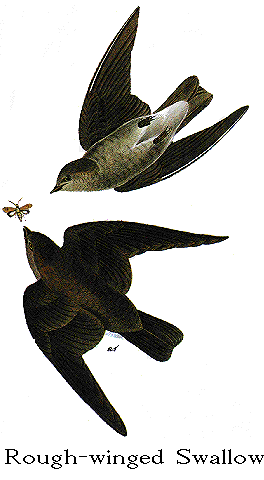Birds of America
By John James Audubon, F. R. SS. L. & E.
VOLUME I.



Family
Genus

ROUGH-WINGED SWALLOW.
[Rough-winged Swallow.]
HIRUNDO SERRIPENNIS, Aud.
[Stelgidopteryx ruficollis.]

PLATE LI.
On the afternoon of the 20th of October, 1819, I was walking along the
shores of a forest-margined lake, a few miles from Bayou Sara, in pursuit of
some Ibises, when I observed a flock of small Swallows bearing so great a
resemblance to our common Sand Martin, that I at first paid little attention to
them. The Ibises proving too wild to be approached, I relinquished the pursuit,
and being fatigued by a long day's exertion, I leaned against a tree, and gazed
on the Swallows, wishing that I could travel with as much ease and rapidity as
they, and thus return to my family as readily as they could to their winter
quarters. How it happened I cannot now recollect, but I thought of shooting
some of them, perhaps to see how expert I might prove on other occasions. Off
went a shot, and down came one of the birds, which my do, brought to me between
his lips. Another, a third, a fourth, and at last a fifth were procured. The
ever-continuing desire of comparing one bird with another led me to take them
up. I thought them rather large, and therefore placed them in my bag, and
proceeded slowly towards the plantation of WILLIAM PERRY, Esq., with whom I had
for a time taken up my residence.
The bill and feet of the Swallows were pure black, and both, I thought,
were larger than in the Sand Martin; but differences like these I seldom hold in
much estimation, well knowing from long experience, that individuals of any
species may vary in these respects. I was more startled when I saw not a
vestige of the short feathers usually found near the junction of the hind toe
with the tarsus in the common species, and equally so when I observed that the
bird in my hand had a nearly even tail, with broad rounded feathers, the outer
destitute of the narrow margin of white. At this time my observations went no
farther.
I perhaps should never have discovered the differences existing between
these species had I not been spurred by the remarks of VIEILLOT, who, in
expressing his doubts as to their identity, and perhaps holding in his hand the
bird here described, says that the tarsus is much larger than in the European
Sand Martin. I have been surprised that these doubts did not awaken in others a
desire to inquire into the subject. Had this been done, however, I should
probably have lost an opportunity of adding another new species to those to
whose nomination I can lay claim, not to speak of such as, although well known
to me previous to their having been published by others, I have lost the right
of naming because I had unparted my knowledge of them to those who were more
anxious of obtaining this sort of celebrity. I have now in my possession one
pair of these Swallows procured by myself in South Carolina during my last visit
to that State. Of their peculiar habits I can say nothing; but, owing to their
being less frequent than the Sand Martin, I am inclined to believe that their
most habitual residence may prove to be far to the westward, perhaps in the
valleys of the Columbia river.
ROUGH-WINGED SWALLOW, Hirundo serripennis, Aud. Orn. Biog., vol. iv.
p. 593.
Tail slightly emarginate, margin of the first quill rough with the strong
decurved tips of the filaments, tarsus bare; upper parts greyish-brown, lower
pale greyish-brown, white behind. Very nearly allied to the last in form and
colour, but readily distinguishable by drawing the finger along the edge of the
wing, when the stiff projecting tips of the filaments are felt like the edge of
a fine saw.
Male, 5 3/4, 12 1/2, in extent.









